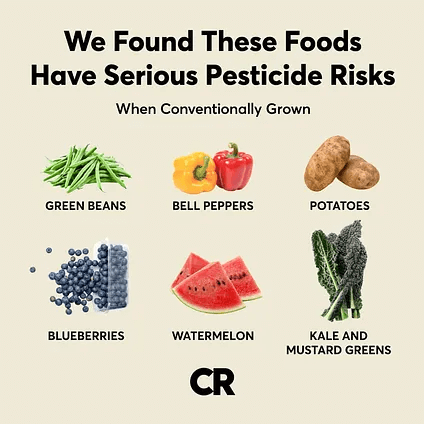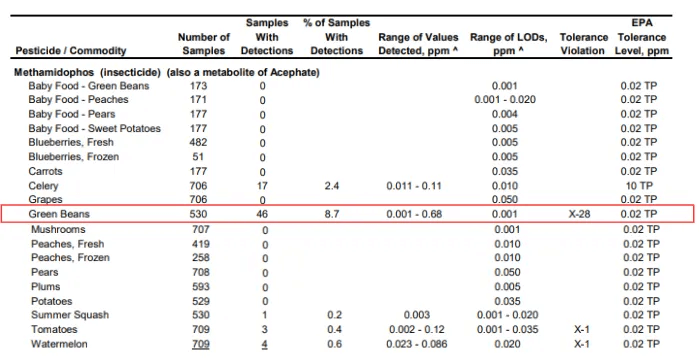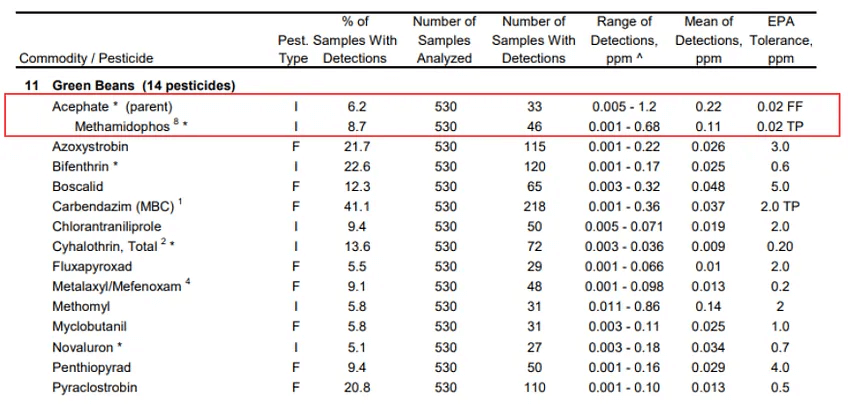Another day, another post from an activist group that is wildly mischaracterizing reality. Consumer Reports has a history of exaggerating toxicological risks related to a wide array of exposures, commonly associated with food products.
Last week, they made an extremely misleading and inflammatory post based on their recent analysis of 59 produce items. Consumer Reports claims that based on their assessment, conventionally grown green beans, bell peppers, potatoes, blueberries, watermelon, and kale have serious pesticide risks.

This is false, reckless, and irresponsible. Trace levels of pesticides on conventionally grown produce items are not cause for concern.
Consumer Report yet again, is exploiting the risk perception gap (read about that topic here) and poorly conducted “science” to scare people into buying organic produce.
Honestly, it feels like I could copy and paste half of what I’ve written about the Environmental Working Group and their Dirty Dozen list when I talk about Consumer Reports, because their approaches to analyzing “pesticides” share common themes. But let’s dig in.
Consumer Reports fudges data to make false statements
Consumer Reports uses the USDA pesticide surveillance data – they do not conduct primary research. They then take these surveillance data and create their own “analysis,” functionally ignoring the scientific consensus of EPA, USDA, and numerous other credible scientific organizations.
Sound familiar? Yes, it’s a very similar tactic to what the Environmental Working Group does when creating their “Dirty Dozen list” (which I discussed here).
In their summary of their assessment, they note that the Alliance for Food and Farming pointed out to them that 99.5% of the produce items they tested were well below the maximum residue levels set by the EPA. Then they follow it with “well we think those levels are too high,” so we toss that out and create our own ranking.
Based on what? Based on nothing. There is no scientific basis for doing this, other than to undermine the scientific and regulatory agencies that are doing incredibly tireless and important work.
Consumer Reports takes the values from the USDA and creates their own “Food System-Dietary Risk Index” (FS-DRI) which is based on flawed methodology:
The Consumer Reports Food System-Dietary Risk Index is completely flawed and created to scare people
Their methodology in reporting ‘high risk produce’ is based on the aggregate levels of residues and number of different conventional pesticide residues while omitting any samples that had zero pesticides detected. That is called data manipulation, folks.
1. They add all of the different trace levels of pesticides together to create an “aggregate” dietary risk score.
This is absolutely absurd, considering that pesticides encompass countless different substances with different mechanisms of action. Their methodology means that if USDA surveillance detects trace levels of a plant growth regulator, a fungicide, and an insecticide on a given produce item, they all get added together with regard to level of pesticide in Consumer Reports’ analysis.
I’m sure you can see why this is flawed, but if not: every single chemical needs to be assessed separately. Every chemical has a different identity, a different mechanism of action, different species they may target, different dosages for safety (and potential harm). You can’t artificially inflate residue levels by adding unrelated and completely different chemicals together and then say PESTICIDES are high.
2. Consumer Reports then OMITS any samples in the given produce category that had no pesticide residues detected.
Way to skew data, Consumer Reports. The irony that that Michael Hansen of Consumer Reports, claims that EPA and USDA “doesn’t reflect cutting-edge science” but:
- Consumer Reports are using the EPA and USDA pesticide surveillance data to conduct their analysis – they aren’t sampling produce items themselves.
- They literally are cherry-picking data to support their narrative.
This is as far from cutting-edge science as possible. This is not science at all.
Consumer Reports claims green beans are high risk, but this is patently false
According to their “ranking,” the only safe green beans to eat are US grown organic green beans. They are telling their readers to avoid eating green beans, a nutritious and safe food item that is a great option as part of a healthy diet.
How any organization can claim to be advocating for consumer health and safety and is dissuading people from eating produce and still say that first part with a straight face is beyond me.

Consumer Reports claims that the risk of green beans is associated with acephate and one of its breakdown products, methamidophos. They say this to cause more fear:
This is especially troubling because neither chemical should be on green beans at all: Growers in the U.S. have been prohibited from applying acephate to green beans since 2011, and methamidophos to all food since 2009.
Let’s talk about acephate
Acephate is an insecticide that is used primarily to control chewing and sucking insect pests, including: aphids, thrips, whiteflies, leafhoppers, caterpillars, beetles, weevils, leaf miners, and mites.
It is an acetylcholinesterase inhibitor, which means that it interferes with the activity of that enzyme in insects. Acetylcholinesterase breaks down acetylcholine at nerve synapses, but when acephate inhibits that, acetylcholine accumulates, leading to overstimulation of the nervous system in insects. This ultimately leads to paralysis and death of the target pests.
Note: while humans (and other animals) also have acetylcholinesterase, our versions of this enzyme are structurally different, which means that acephate does not have that effect on non-insect acetylcholinesterase enzymes.
Now, they claim that acephate “shouldn’t be on green beans” at all, in order to suggest that farmers are somehow risking your health. But they omit that acephate is registered and used on other crops that are grown on farms that are also growing green beans, including: cotton, tobacco, ornamental plants, fruit trees, tomatoes, peppers, potatoes, soybeans, alfalfa, and rice.
Why isn’t acephate used on green beans anymore? A couple of reasons.
- The pests that acephate is primarily targeting on farms are less of a pest concern for green beans, and there are other ways to control them on these crops.
- Acephate is a broad-spectrum insecticide and green beans are often grown in areas where farmers want to avoid the potential broader ecological impacts of broad spectrum insecticides.
- EPA sets tolerance levels for every single pesticide and every single produce item independently. This is determined by many factors including how the crop is used and processed, the target pests, and the toxicity data on the pesticide. Thus, acephate tolerance levels may be higher on other crops like tobacco and cotton, compared to green beans, based on the life cycle of the crop (and pests).
Consumer Reports then states that methamidophos shouldn’t be on *any* crops because it hasn’t been allowed as an application since 2009.
Did they forget the part that methamidophos is a metabolite of acephate? They even stated that. It isn’t being applied to green beans – it is detected as acephate breaks down.
But let’s take a look at the data they cite. Below is the USDA surveillance data as it pertains to acephate, the breakdown product methamidophos, and green beans overall.


USDA Pesticide Surveillance Data, Methamidophos
Consumer Reports correctly notes that only 4% of domestic conventional green bean samples had any detectable levels of either or both. But then they really stir the pot by saying “those that had detectable levels were alarmingly high” and say that it was 100-times higher than what they, Consumer Reports, deems safe.
You’ll note that in the charts above, tolerance violation was noted for green beans. This underscores how rigorous the surveillance BY USDA and EPA is.
The USDA detected tolerance levels that exceeded their safety thresholds in 0.53% of ALL produce samples they tested. 56 samples of 10,665. These are immediately reported to the FDA as well. Consumer Reports is insinuating that USDA, EPA, and FDA are just ignoring these? Well, they’re not.
Of 530 green bean samples tested, 6.2% had detectable acephate and 8.7% had detectable methamidophos. That means that 93.8% had NO detectable acephate and 91.3% had NO detectable methamidophos levels.
Let’s look at the ones with detected levels of acephate and the byproduct, methamidophos. The EPA tolerance on green beans is 0.02 parts per million, or 0.000002%.
The ranges of samples with detectable levels range widely: from well below the tolerance level (the maximum residue level, MRL) to above the MRL. So, when you look at the mean level of detection, that might look concerning, and that’s what Consumer Reports is banking on.
But remember, this does not include the 490 samples that had 0.00 as their detected level. More than that, the mean value is skewed by the one or two outlier samples that had unusually high detections. So, there is a tiny percentage of select green bean samples that had detectable acephate or methamidophos that were above the EPA tolerance level.

Should we be concerned about those outlier detections above the EPA tolerance?
The short answer: noThese MRL values set by the EPA are incredibly conservative based on continual review of all scientific evidence. They are set orders of magnitude below exposures of each chemical that could even theoretically cause harm to people or animals. These MRL levels are to ensure excess caution for everyone, including those that may have higher exposures, have certain risk factors, etc.
More than that, the MRLs are based on detectable levels at the time of harvest. We process produce, even fresh produce, at a minimum, by washing. Washing fresh produce with is very effective at removing trace levels of pesticides.
Detection does not equal clinical relevance
This is a common strategy used by people who spread fear about certain chemicals (ironically, not other chemicals). Everything is chemicals. You’re a sack of chemicals. The dose makes the poison with everything. Consumer Reports seems to have forgotten all of this.
We have some of the most sensitive analytical chemistry tools on the planet. That means, we can “detect” levels of substances that are miniscule. Parts per million. Parts per billion. Parts per trillion. For context: a part per million (ppm) is one part per 1,000,000 parts. A part per billion (ppb) is one part per 1,000,000,000 parts. A part per trillion (ppt) is one part per 1,000,000,000,000 parts.
These are tiny values being detected in small percentages of sampled produce items.
Would I personally be concerned about this or any of the conventionally-grown foods Consumer Reports is demonizing? Absolutely not
Consumer Reports’ solution is to buy organic, but they omit residual levels of organic pesticides for their analysis.Their solution to avoid all these “risky” produce items? Just like the EWG, you can buy organic produce instead!Of course, they conveniently omit that organic farming also uses pesticides, and of course those pesticides weren’t included in their “analysis”.
Reminder: organic farming uses plenty of pesticides.Organic pesticides are merely pesticides that remain chemically unaltered from the chemical state derived from nature. Before you fall into the appeal to nature fallacy trap, remember that the suffix ‘-cide’ means “to kill”. It doesn’t matter whether a pesticide is a natural chemical or a synthetic chemical: they all kill certain things at certain exposures. Remember: the dose makes the poison. (read more about this topic here).
Synthetic pesticides are chemicals that are produced from chemical alteration. But the source of a chemical has zero bearing on its potential harm or safety. and In reality, some naturally procured pesticides are deadlier or carry a higher risk than synthetic options. Plants produce lots of noxious chemicals to deter predators from eating them.
Regulation and safety monitoring is more stringent for synthetic pesticides
The U.S. Environmental Protection Agency (U.S. EPA) has a rigorous process that requires the product demonstrate no risk to human health if used correctly (I discussed that here). All pesticides must go through a registration process requiring a review of data on the safety of the product which include many pesticides used in organic agriculture. These data are used to construct pesticide labels which anyone who uses them must legally follow.
Most natural pesticides haven’t been tested for their toxic potential, as the Reduced Risk Program of the US Environmental Protection Agency (EPA) applies to synthetic pesticides only. Many natural pesticides have been found to pose potential – or serious – health risks, including those used commonly in organic farming. This is also why Consumer Reports conveniently “omits” all organic pesticide residues: because they are not monitored or regulated as stringently.
These tolerance levels of residues for synthetic pesticides on food are continually monitored – that’s why Consumer Reports has data to analyze! However, for some organically-approved pesticides, no tolerance level is set.
Organic products are not healthier, safer, better for you, better for the environment, or better for farmers
I discussed all of these misconceptions here. Organic products are more expensive, though, and that’s about all they offer.
By fomenting false fear about safe and nutritious conventional product, Consumer Reports and every major news outlet that has picked up this flawed analysis are contributing to spreading disinformation and exacerbating health anxiety.
Demonizing affordable and nutritious conventional produce is harmful and Consumer Reports is contributing to this
The false dichotomy between conventional and organic isn’t just misleading, it’s dangerous. Our constant attention on natural versus synthetic only causes fear and distrust, when in actuality, our food has never been safer.
Eating fewer fruits and vegetables due to fear of pesticides or the high price of organic food does far more harm to our health. Conventional produce has the same nutritional content and is as safe to consume as ‘organic’ produce. Most of Americans already don’t eat enough fruits and vegetables, and produce contains important nutrients, fiber, and other substances that are extremely important to our health.
Instead of assuring people of the robustness of our surveillance and regulatory agencies, Consumer Reports tells people to NOT eat conventional produce. It is reckless and irresponsible.
From a scientific point of view, organic foods are not superior. If you want to spend more money on them, go for it. But don’t buy organic because you think it’s better for you or for the planet, because it’s not.
If you found this useful, please share with friends and family, especially though who fall prey to fear-based headlines. If you know a reporter who has written on this or other EWG claims, please send it to them as well.
Anti-science rejection and science misinformation is a global public health threat. This is no time to be complacent about this. This discussion is not about “industry” or “government” – it is about activist organizations and the media outlets they have relationships with spreading lies about scientific data. All of us can help combat the spread of these falsehoods.
Dr. Andrea Love has a PhD in Immunology and Microbiology. Andrea is a subject-matter expert in infectious disease immunology, cancer immunology, and autoimmunity and is adept at translating complex scientific data and topics for the public and healthcare providers. Follow Andrea on X @dr_andrealove
































